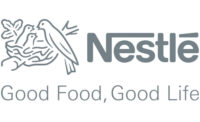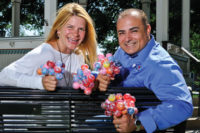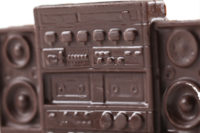
(From l. to r.) Biki Khurana, managing director of Plantagenkakao division; Jürgen Rausch, president and ceo; and Burkhard Eckermann, coo, hold various single-origin chocolates from the famed Plantagenschokolade line in front of the new Rausch Factory East campus.

In sitting down for a series of interviews withCandy Industry, Rausch admitted the fact.
“Yes, I have two hearts in my body,” he explains. “Going back to my great-grandfather, my grandfather and my father, we have always been idealists. I want to do good things.
“At the same time, as a specialist in premium chocolates, I’m always thinking about quality.”
And while a recent checkup revealed that Rausch remains a mere mortal like the rest of us – he only has one heart – his spiritualHerz is large enough to embrace both pursuits with a fervor few can match.

(Top to bottom) A Winkler and Dünnebier chocolate moulding line, capable of running 32 moulds per minute, deposits chocolate for the 40-gram sticks. The sticks then proceed to a Theegarten-Pactec flow wrapper before being directed to single-pack cartoning or a four-pack overwrapping.
During the past three years, the company has doubled in size, growing in sales from 45 million Euros to nearly 100 million. It has paralleled the revenue surge with volume growth by investing 25 million Euros in automation and processing lines, thus pushing annual chocolate output from its Peine, Germany manufacturing facility to 22,000 metric tons.
By carefully balancing brand building with volume private-label sales, while never wavering from the company’s strict commitment to quality, Rausch has introduced millions of consumers to better chocolate.
Naturally, such rapid growth has garnered Rausch not only increased press coverage, but added scrutiny from competitors, prompting many to copy the program if not the process. Fortunately, most consumers recognize that imitations rarely measure up to originals.
And with this most recent kudo, the 2008 European Candy Kettle Club Award, Rausch receives recognition not only for his long-standing commitment to the family business, but for his efforts toward the fine- flavored cocoa industry as well- efforts that go a long way to respecting the source of his success: the cocoa bean and the farmer.
Still, were it not for his father’s illness back in 1970, Rausch could have been spearheading advertising campaigns in Germany as opposed to making fine chocolates. But as he explains, when he opted to postpone his trip to Boston to work at Chase Manhattan Bank in order to help out in the family business at the tender age of 22, he thought it would be only for six months.

Volume production of sticks and bars flows into a LoeschPack wrapping line.
Rausch’s work ethic – and natural abilities -- stood him in good stead, however, and the company’s gradual growth eventually led to moving operations from then Wall-locked Berlin to Peine as part of a necessary expansion.
But it was another reality, the consolidation of specialty shops from 10,000 to 1,000 in Germany during the mid 1980s and early 1990s that led the now-seasoned chief executive to transform the company from being a full-line chocolate producer to a highly specialized, fine-flavored cocoa pioneer.
In analyzing the market during the late 1990s, Rausch not only saw the influence of supermarkets on the marketplace, but also recognized a gap within the chocolate bar segment.

Packing inspectors check flow-wrapped 40-gram sticks coming off a Theegarten-Pactec unit before they head to a Somic pick 'n place machine that puts the sticks into pre-formed boxes.
As he explains, the idea reflected, in part, his family’s creative streak in chocolate making.
“My grandfather was the first to develop thin chocolates,” he says. “It was my father who came out with petit petites, mini pralines.”
And so it was Jürgen Rausch who launchedRausch Plantagenschokoladein 1999, a line of eight chocolate bars that uses only 100% fine-flavored cocoa from farms and plantations located in the best growing areas of the world. Today’s assortment of fine-flavored chocolate bars includes: Nouméa milk chocolate with 35% cocoa content from Papau New Guinea; Madanga milk chocolate from Madagascar with 39% cocoa content; Puerto Cabello milk chocolate from Venezuela featuring 43% cocoa content; Guácimo milk chocolate from Costa Rica with 47% cocoa content; Amacado, dark chocolate from Peru with 60% cocoa content; El Cuador, dark chocolate from Ecuador with 70% cocoa content; Tobago, dark chocolate from Tobago with 75% cocoa content; and Tembadoro, dark chocolate from Trinidad with 80% cocoa content.
ThePlantagenschokolade line quickly acquired a following, one that eventually led to Rausch partnering with Lidl, the world’s tenth largest retailer based in Germany that has nearly 8,000 retail units.
Again fate intervened, this time as a phone call.

Two weeks later, the two chief executives met and worked out a deal whereby Rausch would produce single-origin bars under the J.D.Gross brand for Lidl.
“We would use only fine-flavored cacaos, but opt for regular sugar and lecithin as opposed to cane sugar and no lecithin for our Plantagenschokolade line,” he points out.
The Lidl partnership enabled Rausch to expand his access of the German market from 50% to 75%. Supermarkets, wholesalers and specialty shops accounted for 50% of the retail outlets, while discount giants Lidl and Aldi each comprised 25% of the remaining half.
More importantly, for Rausch it was a critical strategic move in accelerating the company’s growth. At the same time, it placed extreme pressure on Rausch to ensure adequate sourcing of fine-flavored cocoa beans to meet volume demand.
Of course, Rausch had visited numerous farms and plantations in establishing reliable sources of supply for fine-flavor cocao beans, working with governments, brokers, cooperatives and even individual farmers to further develop the segment.
In doing so, he’s remained adamant about seeing that farmers not only realize a quality yield from the trees, but better wages for their hard work. Consequently, Rausch always looks to remove the middlemen – there can be three to four layers between the farmer and the cacao processor – so as to deliver as much value as possible to the farmer.
To help him attain his goal, he hired Biki Khurana, managing director of the Plantagenkakao division, to not only help him guarantee the existing pipeline flow of fine-flavored cocoa beans, but to introduce best practices involving pruning, fermentation and drying in new growing areas as well.

Executives Burkhard Eckermann and Jürgen Rausch check filled pralines that have been scaled and filled into a specially designed serving box formed on a Mohrbach packaging line.
Another emerging issue for Rausch is the scarcity of the fine-flavored cacao. According to the International Cocoa Organization, fine-flavored cacaos have decreased as a percentage of the total cocoa crop from 5.3% to 4.8%.
“High quality raw materials, such as fine-flavored cocoa, are becoming very scarce,” Rausch said. “That’s why we have to do something for the future.”
With Khurana’s involvement, it’s already happening. This year, Khurana and Rausch struck a deal with the Madagascan government to oversee the planting of 1,700 hectares (4,199 acres) with fine-flavored cocoa trees. This will mark the first time that Rausch becomes its own supplier of cocoa beans.
“We have many partners who acquire and process the cocoa beans,” explains Khurana, “We work very closely with these partners in every country and will continue to do so. But to expand availability for fine-flavored cocoa beans for the company, we’re going to be a direct source of beans as well.”
During the past three and a half years, Khurana and Rausch have spoken directly to government representatives in Ecuador, Peru, Costa Rica, Trinidad & Tobago, Papau New Guinea and, of course, Madagascar, to further develop growing regions.
But just as Rausch has engaged Khurana to expand the availability of fine-flavored cacao beans, he’s simultaneously focused attention on producing chocolate bars more efficiently to meet the growing demand for premium chocolates.

Jürgen Rausch holds the European Candy Kettle Club award accompanied by wife, Petra and son, Robert, as well as officers of the European Candy Kettle Club, President Mike Dalby (second from left) and Vice President Dee Wakefield (far left), and Jim Heinz (far right), former chairman of Candy Industry's Candy Kettle Committee in the United States.
But when the opportunity surfaced in 2007 to acquire Panasonic’s offices and CD production facility encompassing nearly 32,000 square meters (340,000 sq. ft.) just down the road from his plant, Rausch didn’t hesitate.
In doing so, he’s converted two-thirds of the area into a logistic center, providing warehousing for finished goods as well as packaging and other materials. The previous Panasonic administrative offices have been remodeled and now serve as new offices for purchasing, sales and finance.
In addition, one-third of the remaining production space has been converted into a co-packing and production area that features new Rasch and Hatec packaging units. Within that area, there’s still plenty of space for future chocolate production lines as well, lines that will probably go into operation by the end of 2009.
To help him oversee the ongoing expansion of production, Rausch brought Burkhard Eckermann on board as the chief operating officer. Eckermann, who previously worked at Storck, points out that the company grew extremely quickly during the past three years.
“My goal is, of course, to ensure that we continue to monitor and improve the quality of our products,” he says. “In addition, we’re focused on also improving efficiencies as well as improving the skills and knowledge of employees.”
As it stands, the company expects to boost output to 25,000 tons in 2009.
Rausch, who’s also conscious of the tremendously rapid growth rate the company has experienced the past few years, says now is a good time to take stock of where the organization is at this point in time and what lies ahead.
With Khurana and Eckermann, Rausch is confident of having two gifted professionals carry on the critical tasks of cocoa bean sourcing and chocolate production. At 60, Rausch notes that he has the next five years to fine-tune the workings of the company as well as address the needs of the farmers and develop new growing fields.
This year the company will complete the transition to a SAP system, which will improve tracking of raw materials and finished goods in real time. The nearly one million Euro investment, which includes software, hardware, training and new staff, represents a significant step in earmarking areas for continuous improvement.
“2009 will be a year of organization for us,” he explains. “This month we’ll review our planning for the next five years.”
During that time Rausch expects to spend nearly 50 million Euros on new equipment and production lines as well as factory upgrades to meet projected demand. As part of the plan, the chief executive also acquired land between his existing facility (Rausch Factory West) and the Panasonic buildings (Rausch Factory East and the Logistics Center) for the construction of a greenfield facility. Preliminary plans call for a new 28,600-sq.-meter plant within the next few years, which would then connect all the facilities together in a single row. If realized, the total office, production and warehousing space of the Rausch Chocolates campus would total 67, 580 square meters (727, 161 sq. ft.)
Realistically, Rausch believes he can double sales to 200 million Euros in five to seven years. Part of the increased turnover will come from new markets, such as the United States. This year, the company, in conjunction with a U.S.-based distribution partner, will debut the Plantagenschokolade line in 300 specialty stores. Within two years, he expects to be in 1,500 stores.
Recognizing that consumers still expect ongoing innovation from chocolate manufacturers, Rausch promises to introduce some “special” products during the upcoming ISM show in 2009. Having spearheaded such concepts as the 40-gram chocolate stick as well as the 6.7-gram individual “gold bar” piece, Rausch looks to showcase his creative skills once again.
But as he initially told Candy Industry during the onset of interviews, he refuses to forget about those that actually supply the company with cocoa beans.
“After 25 years of working with the Lions Club in Berlin, I told them that the time has come for me to do other things,” he explains. “So this year, I established a Cocoa Trust, which directly helps farmers involved in cultivating fine-flavored cocoa beans.”
In the end, it’s simply a matter of having your heart(s) in the right place.

At a glance
Rausch Schokoladen GmbHHeadquarters: Peine, Germany
Sales: 100 million Euros ($140 million)
Brands: Plantagenschokolade
Employees: 550 (320 permanent and 230 seasonal)
Output: 22,000 metric tons annually
Management team: Jürgen Rausch, president and ceo; Biki Khurana, managing director - Plantagenkakao division; Burkhard Eckermann, chief operating officer; Timon Hoppe, purchasing manager; Olaf Büttner, sales manager.









